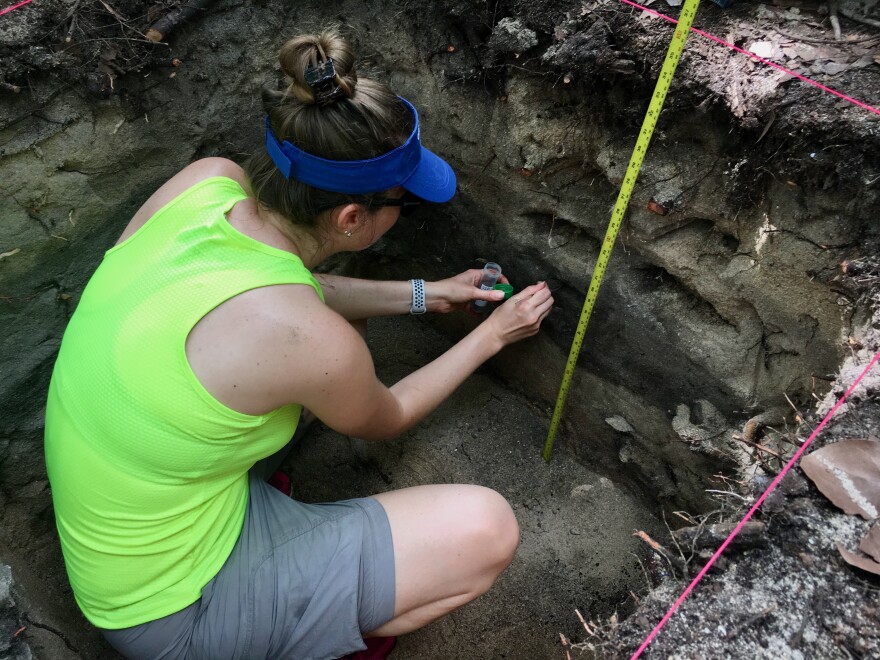Long before Ponce de Leon arrived in Florida, native people called Palm Beach County home , and many archaeological sites related to the senative people can be found throughout the county. But climate change may affect some of these sites .
The South Florida Regional Climate Change Compact has developed an action plan to provide coordinated climate action in Southeast Florida. Researchers at Lynn University in Boca Raton conducted a study that found sea-level rise is impacting some areas in Palm Beach County.
Dr. Alanna Lecher is a geologist and associate professor at Lynn University. She co-authored the study that was published in the journal Southeastern Archeology in 2021.
Although studies have been conducted about the long-term effects of sea-level rise on archaeological sites, Lecher claims this one is different.
“Most other studies have to do with what is known as flooding from the top, " she said. "Our study shows that artifacts are actually starting to get wet from the groundwater seeping up below. As artifacts repeatedly get wet and dry it makes them a lot more fragile and likely to break upon excavation.”
Lecher and her colleague, April Watson, an archeologist, worked with a team of students from Lynn University to excavate two sites at South Inlet Park in Boca Raton. Their findings revealed that groundwater is submerging the sites in water long before they would be flooded by sea level rise.
“It may take 100, 300, 400 years for this site to get flooded by the ocean but now these sites are already being impacted by the rising groundwater, ” Lecher said.
They excavated a portion of a shell midden — also known as a refuse mound — consisting mostly of oyster and conch shells, likely left by the native Jeaga people. The mound is covered in dry sea grape leaves and is 10 feet from the park’s playground.
“I’m sure a lot of kids come and play here and don’t realize it’s here ," Lecher said. "And I think this is the story of many of the archaeological sites in the state of Florida.”
Sara Ayers-Rigsby is the director of the Southeast and Southwest Regions of the Florida Public Archaeology Network. Their mission is to promote the conservation and public understanding of Florida’s archaeological heritage.
“There’s not a lot of public education about local archeological history ," Ayers-Rigsby said. "Kids are learning about the archaeology in Egypt, Greece and Rome but they don’t necessarily learn about what’s in their backyard. We’re here to fill that gap.”
Lecher and her colleagues found several artifacts, including fish vertebrae, fish skull, deer, fresh water turtles and sea turtles — all smaller than the size of a fingernail.
The native Jeaga people occupied what is now Palm Beach County, from the Boca Raton inlet to the Jupiter inlet. Ponce De Leon first encountered them when he made landfall at the Jupiter inlet in the early 1500s. Unfortunately, the Jeaga population was decimated by warfare, enslavement and European diseases.
The South Florida Regional Climate Change Compact, a partnership between Broward, Miami-Dade, Monroe, and Palm Beach counties, works collaboratively to reduce regional greenhouse gas emissions, implement adaptation strategies, and build climate resilience within their own communities and across the Southeast Florida region.
As part of the Compact’s Southeast Florida Regional Climate Action Plan, they want to identify and map at-risk historic and archeological resources — specifically, those that are susceptible to sea-level rise and other natural disasters. These maps would be included in the comprehensive plans and regional planning documents to guide municipal and county government climate adaptation planning efforts.
Ayers-Rigsby was instrumental in helping to develop recommendations for the archaeological resources portion of the action plan.
Lecher and her team are still identifying all of the artifacts from the site and have plans for a follow-up study soon.
Copyright 2022 WLRN 91.3 FM. To see more, visit WLRN 91.3 FM.




